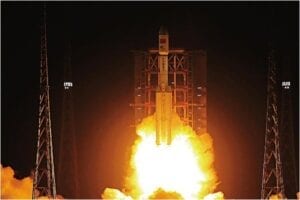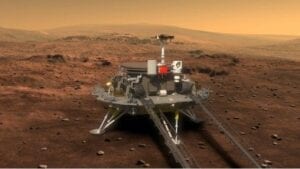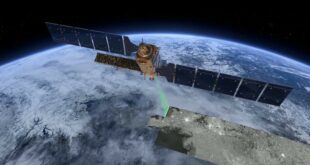by Blaine Curcio and Jean Deville
 As part of the partnership between SpaceWatch.Global and Orbital Gateway Consulting we have been granted permission to publish selected articles and texts. We are pleased to present “Dongfang Hour China Aerospace News Roundup 24 May – 30 May 2021”.
As part of the partnership between SpaceWatch.Global and Orbital Gateway Consulting we have been granted permission to publish selected articles and texts. We are pleased to present “Dongfang Hour China Aerospace News Roundup 24 May – 30 May 2021”.
Hello and welcome to another episode of the Dongfang Hour China Aero/Space News Roundup! A special shout-out to our friends at GoTaikonauts!, and at SpaceWatch.Global, both excellent sources of space industry news. In particular, we suggest checking out GoTaikonauts! long-form China reporting, as well as the Space Cafe series from SpaceWatch.Global. Without further ado, the news update from the week of 24 May – 30 May 2021.
1) Launch of Tianzhou-2 Cargo Mission
Blaine’s Take

This week, we saw the successful launch of the Tianzhou-2 cargo spacecraft from Wenchang, onboard a Long March-7 rocket. The Tianzhou-2 mission is the first cargo mission to be sent to the recently-launched Tianhe core module of the Chinese Space Station, and will be followed next month by the launch of the Shenzhou-12 crewed mission, which will carry 3 Taikonauts to the now well-stocked space station. As of several hours ago on 30 May 2021, we received news that the Tianzhou-2 vessel had successfully docked with Tianhe.
A few points to discuss, about both the rocket and the cargo vessel:
This was the first launch of the standard LM-7 since April 2017, when we saw the Tianzhou-1 cargo vessel sent to the since-deorbited Tiangong-2 space station. Since then, we have seen two attempted launches of the LM-7A, a GTO variant of the LM-7, one of which was unsuccessful. Xu Lijie, the Chief Designer of the Long March-7 rocket, was interviewed at Wenchang a couple of weeks ago, where he discussed some of the improvements that had been made to the LM-7 Yao-3 compared to the Yao-2*. This includes higher precision of the launch window due to the complexities of synchronizing the launch with the position of the space station.
Regarding the cargo vessel, this is the second time that China has launched its new-generation Tianzhou autonomous cargo vessel. Tianzhou has a liftoff mass of around 13 tons, and around half of that weight would be used for cargo (hopefully some of that 6,500kg is reserved for a few jars of 老干妈!).
One last thing that stuck out on my side was, once again, the apparent pilgrimage of Chinese space industry fans going to Wenchang to watch the launch. In particular, a great video was circulating around Twitter whereby a news anchor was interviewing a handful of young people after the launch. The people were wearing custom-made “China Space” shirts (中国航天), and were gushing about the pride they felt in seeing the LM-7 reach orbit. Impressively, one of the interviewees mentioned that they had traveled to Wenchang three times, with the first two launches being delayed. While it may have been hyperbole, one interviewee said that this was likely to be the event that left the biggest mark on her life (最深刻的印记). Last point was that the people being interviewed were university students that are graduating this year–good to see young people entering the workforce being enthusiastic about space.
Jean’s Take
I’d like to add some insights on the technical specifications of Tianzhou. Tianzhou is about 10-ish meters long, which makes it fit snugly in the LM7 payload fairing which is 12.5 m long. It is composed of a service module, which contains many systems like propulsion, electric power and comms, and of an orbital module which contains the cargo. The orbital module has a diameter of 3.35 m, filling as much as possible the payload fairing, while the service module’s diameter is only 2.8m (this enables the Chinese to fit various subsystems on the exterior of the service module).
There are actually some differences between Tianzhou 1 and Tianzhou 2 that i want to cover:
- First of all, Tianzhou is available with 3 different orbital module configurations. The initial Tianzhou-1 from 2017 was a fully pressurized version, where after docking with the CSS, it is directly the taikonauts that transfer the cargo from the orbital module racks to the space station.
The two other configurations are the semi-pressurized and the non-pressurized versions, and in which the robotic arm of the CSS is used to extract and move around the cargo. This is notably useful when sending larger systems to the CSS. Tianzhou-2 will be a semi-pressurized version. - Another small and less visible difference is that the Tianzhou-2 orbital module will have a small circular interface for the robotic arm end effectors to attach. Why is that, do you ask? Tianzhou-2 indeed is equipped with a number of radar and laser sensors enabling the spacecraft to perform an autonomous docking, it does not need the robotic arm.
The answer is, this additional interface is to test the robotic arm’s ability to help a spacecraft dock, as this will be how Mengtian and Wentian, the future experimental modules of the Chinese space station, will dock to the core module.
So back to Tianzhou-2: it first docked to the back of the CSS. Following a visit and departure of the Shenzhou 12 crewed spacecraft, Tianzhou-2 will then detach and dock to the front docking port in the axial direction. Finally, after the arrival of the crew of Shenzhou 12, Tianzhou-2 will undock again, and this time the robotic arm will capture it, move it to another docking port and help it perform docking.
Overall, while Tianzhou-2 is bringing some cargo to the Chinese Space Station, it actually also has a very unique role in the Tianzhou series as a technology verification mission.
For those looking for some additional information on Tianzhou in English, there’s a (dated) article from Spaceflight101 which is very resourceful. There is also a good piece on Zhihu (in mandarin) discussing the aforementioned robotic arm interface on Tianzhou-2.
2) China’s Efforts to ensure a successful deployment of Zhurong on the Martian ground
Jean’s Take
The world is in the throes of a Martian Summer. We have no less than 2 rovers, a helicopter, and multiple orbiters, all built and launched by humans, traversing the Red Planet and its orbit all summer long. While we may not have breaking news every week, this is clearly a significant event for humankind. Given the role that China is playing in this Martian Summer, we plan to give you at DFH as many insights as possible every week on what is going on.
And now that Zhurong has landed on Mars and that the Zhurong rover has successfully driven off the lander, a lot of content is appearing on the Chinese Internet.
In this episode, we want to discuss the measures that were taken to make sure that the Zhurong rover drove off safely the ramp that led it from the lander platform to the Martian soil. This is indeed a perilous maneuver, performed on a pair of skinny little ramps (as you can see on the picture). And the dangerous nature of the maneuver is confirmed by the amount of time it took Zhurong to perform this “drive-off”: Zhurong landed on Mars on May 14th, but it only left the lander 8 days later on May 22nd. A lot of verification tests were going on during this period to make sure that nothing would go wrong when Zhurong would start to drive down the lander ramps.
Let’s briefly recap some of the things the Zhurong rover did upon landing:
- one of the first tasks of the rover was to image its surroundings with the two navigation cameras on the rover front mast, with the objective of getting a good understanding of the environment before the drive-off attempt.
An important point worth noting, the deployment ramps of the lander were designed to be able to deploy in two opposite directions, according to Tianwen-1 deputy head designer Zhang Yuhua. And that’s why the cameras played a major role: the images captured by the cameras would determine the direction with more favorable conditions to deploy the rails. - After imaging is performed comes step 2: 400 million km away from Zhurong, the Tianwen-1 technical teams set up a replica of the Zhurong rover and lander in a simulated martian environment, taking into account the inclination of the lander, the local topography, and even the position of various rocks and obstacles captured by the Zhurong navigation cameras. The reproduction of the martian environment went as far as taking into account the lower gravitational field on Mars (roughly 3/8) by adding a sophisticated cable attached to the top of the rover and which would continuously provide an upward force of 5/8 of Zhurong’s weight on Earth. Multiple light sources were also placed in the lab to simulate the exact amount of sunlight the rover would be getting, as well as the inclination of the sun rays.

The angle of the rails were determined to be around 20° (with the design maximum being 35°). After multiple trial-and-error attempts on driving off the mock rover, including trying different speeds and control parameters, the Tianwen-1 technical teams ended up getting a performance which was considered to be optimal for a safe deployment of Zhurong. These parameters were then uploaded from the replica to the real Zhurong rover 400 million km away to replicate the same descent.
Last fun fact, the descent time was 425 seconds, for rails that looked to be around 5-6 meters (when visually compared to the size of the rover). That’s roughly 0.05 km/h!
Blaine’s Take
50 meters per hour, incredible, especially when compared to the speed at which Tianwen was traveling when going from Earth to Mars. An article here from the Scientific American indicates that the rover’s top speed may be as much as 200 meters per hour….still not exactly speedy. An interesting thought exercise–I kind of wonder how long it would take for Zhurong to reach Percy traveling at their respective top speeds. Clearly most of the Martian surface is not traversable by these rovers, so such a thing won’t be taking place unless we get a lot more stuff happening on Mars, but either way, interesting thought–that’s a big rock, and these are some slow-moving rovers. More in the coming weeks on the Martian Summer.
3) Euroconsult Webinar Takeaways
Blaine’s Take
Euroconsult hosted a China Space Industry webinar this past Thursday, and it was a doozy. Five panelists from five of China’s premier commercial space companies sharing the stage for an 80-minute conversation. Represented was 1x pure-play satellite manufacturer (Commsat), 2x hybrid manufacturers/operators (CGSTL, Spacety), 1x launch company (Galactic Energy), and 1x TT&C company (the amazingly-named Satellite Herd. Name-wise, it is the antithesis of JZYJ).
The event will eventually be posted online, but in the meantime, a short summary of the main takeaways:
Appropriately, Spacety was the only company who’s participant was dialing in from outside of China. CEO of Spacety Luxembourg James Zheng dialed in from Montreal, and discussed Spacety’s role as arguably the most international commercial space company in China. The company has been aggressive in finding foreign partners, partly through its rapid launch cadence (lots of satellites going into orbit that can be used for testing new technologies), and its company culture.
From CGSTL, we got a few interesting nuggets of information. First, according to company VP and Chief Engineer Zhong Xing, CGSTL is now at around 500 employees, of which more than 80% have a Masters’ degree or PhD. This would make CGSTL one of the larger commercial space companies in China, though still a drop in the proverbial bucket compared to behemoths like CASC (180,000 employees), or even high-level CASC subsidiaries such as CAST (~20,000 employees). From CGSTL we also heard that their goal to have 60 satellites in orbit will be reached by “end of 2021 or beginning of 2022”, which is a delay compared to their “end of 2021” goal mentioned earlier this year. Finally, Dr Zhong may have been feeling conservative, but he did mention that the company’s 138-satellite constellation will be in orbit by 2030, as opposed to the recently-announced “end of the 14th Five-Year Plan” period i.e. end 2025.
Galactic Energy reaffirmed their target date of 2023 for the inaugural launch of the Pallas-1 rocket, having successfully launched their Ceres-1 for the first time in November 2020. Claire Wu, Director of Communications at Galactic Energy, highlighted the company’s independently-developed “Edge” series attitude & orbit control power system, as well as the company’s “Light Year” solid (光年) and “Welkin” liquid (苍穹) engines. As one of the “younger” Chinese commercial launch startups, having been founded in early 2018, Galactic Energy has progressed impressively quickly, having become the second commercial Chinese company to launch a rocket into orbit with their aforementioned Ceres-1 launch. Also mentioned by Wu was the company’s recent deal with China Huateng, as discussed recently on Dongfang Hour Episode 33.
Commsat reaffirmed their goal of completing the company’s Tangshan (Hebei) satellite factory by mid-2021 with a capacity of 100 satellites per year, with the factory being billed as the “first privately-owned satellite mass production line in China approved by the NDRC”. The company presented some updates on their vertical market R&D, including developing IoT applications for oil & gas, mining, and logistics. Dong Lu, the company’s Director of Strategy, noted that Commsat’s value proposition is to have a fully turnkey service. According to Dong, some companies would require only satellites, but some companies would require satellites + constellation planning service, some might require both of these things + application development, etc. In short, Commsat hopes to be a sort of “one-stop shop”.
Satellite Herd was the relative dark horse in this webinar. The company is the only one that is currently making money, and their business model is very different from the other 4, in that Satellite Herd does not have huge R&D/CAPEX for years before realizing any revenues. The company’s COO, Dong Wei, discussed some of Satellite Herd’s achievements as China’s leading commercial TT&C company. According to Dong, company has an ~80% market share of commercial TT&C business in China, and is currently providing or has provided TT&C services to 71 satellites and rockets. Moving forward, Satellite Herd is developing software for constellation management, and is building out their TT&C network.
Overall, an interesting webinar for sure. A couple of other highlights–one audience question was particularly appropriate–”how do you guys work together?”, which created a great opening for these companies to open up about how collaborative Chinese commercial space companies tend to be. First, everyone buys TT&C services from Satellite Herd. CGSTL buys payload-related parts from Commsat, while Spacety cooperates with both Commsat and CGSTL on different things. CGSTL, among others, have held talks with Galactic Energy about commercial launch services. It could be speculation, but I think one of the elements that encourages the cooperation mindset is the extent to which commercial companies are living in a very different world from the SOEs in the Chinese space sector. In short, the precariousness of one’s existence as a Chinese commercial space firm might make it more advantageous to stick together with other commercial space firms.
This has been another episode of the Dongfang Hour China Aero/Space News Roundup. If you’ve made it this far, we thank you for your kind attention, and look forward to seeing you next time! Until then, don’t forget to follow us on YouTube, Twitter, or LinkedIn, or your local podcast source.
Blaine Curcio has spent the past 10 years at the intersection of China and the space sector. Blaine has spent most of the past decade in China, including Hong Kong, Shenzhen, and Beijing, working as a consultant and analyst covering the space/satcom sector for companies including Euroconsult and Orbital Gateway Consulting. When not talking about China space, Blaine can be found reading about economics/finance, exploring cities, and taking photos.
Jean Deville is a graduate from ISAE, where he studied aerospace engineering and specialized in fluid dynamics. A long-time aerospace enthusiast and China watcher, Jean was previously based in Toulouse and Shenzhen, and is currently working in the aviation industry between Paris and Shanghai. He also writes on a regular basis in the China Aerospace Blog. Hobbies include hiking, astrophotography, plane spotting, as well as a soft spot for Hakka food and (some) Ningxia wines.
 SpaceWatch.Global An independent perspective on space
SpaceWatch.Global An independent perspective on space




